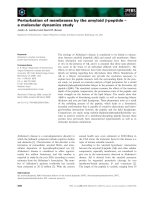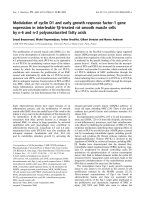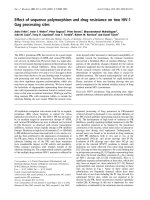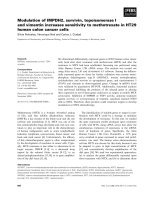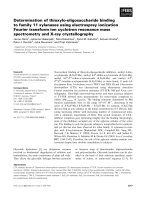Báo cáo khoa học: "Determination of Roxithromycin by Liquid Chromatography/ Mass Spectrometry after Multiple-Dose Oral Administration in Broilers" pdf
Bạn đang xem bản rút gọn của tài liệu. Xem và tải ngay bản đầy đủ của tài liệu tại đây (191.22 KB, 5 trang )
J O U R N A L O F
Veterinary
Science
J. Vet. Sci. (2003), 4(1), 35-39
Abstract
6)
A highly sensitive and specific method for the
determination of roxithromycin in broiler tissues by
LC/MS w as developed and validated. A dichloro-
methane extract of the sample w as separated on C18
reversed-phase column w ith acetonitrile-50 mM am-
monium acetate (80:20, v/v) as the mobile phase and
analyzed by LC/MS via atmospheric pressure ioni-
zation/e lectrospray ionization interface . The limit of
detection and limit of quantitation w ere 1 ng/g and 5
ng/g. The m ethod has been successfully applied to
determine for roxithromycin in various tissues of
broilers. Residue concentrations w e re associated with
administered dose. At the termination of treatment,
roxithromycin w as found in all collected samples for
both dose groups. Liver w as detected to have the
highest residual concentration of roxithromycin. Re-
sidue concentrations of roxithromycin were low er
than its LOQ in all tissues from both dose groups 10
days after the treatment of roxithrom ycin mixed w ith
drinking w ater at a dose rate of 15 mg/L or 60 mg/L
to each broiler for 7 days.
Key w ords
: roxithromycin, broiler, LC/MS, withdrawal time
Introduction
Roxithromycin is a semisynthetic macrolide antibiotic de-
rived from erythromycin [12]. Roxithromycin was reported
to be absorbed rapidly with the long elimination half time,
giving higher plasma levels than erythromycin [9]. There-
fore, it can be effective at lower doses with less frequent
administrations, which is regarded as an advantage in cli-
nical settings. Due to these advantages, it could be applied
*
Corresponding author: Hyo-in Yun
Division of Veterinary Pharmacology and Toxicology, College of
Veterinary Medicine, Chungnam National University, 220 Gung-dong,
Yuseong-gu, Daejeon, Korea
Tel: +82-42-821-6759; Fax: +82-42-822-5780
E-mail:
in human and veterinary medicine [8].
Several methods have been reported for determination of
roxithromycin in biological fluids. Microbiological assays in
plasma, urine and milk have been reported [4]. However,
microbiological assays have several disadvantages in terms
of the limit of quantitation, specificity and rapidity. Some
methods based on the reversed-phase HPLC have been
developed for the qunatitation of roxithtomycin or other
macrolides. UV absorption [2, 11, 14], fluorescence and elec-
trochemical detection [3, 5, 13, 15] methods have been used,
but these methods achieved only relatively high detection
limits in the range of several hundred ng/g or ng/ml. They
are not suitable to determine low levels of roxithomycin in
the biological fluid.
More recently, the advent of mass spectrometer combined
with HPLC offers a significant advantage for the absolute
confirmation and quantitation of chemicals. The high-per-
formance liquid chromatography (HPLC) coupled to elec-
trospray mass spectrometric detector could be a more
powerful technique for separation, identification and quan-
titation of roxithromycin [4, 7, 10, 6]. Electrospray mass
spectrometry and particle beam mass spectrometry have
been coupled to LC for the analysis of roxithromycin in
biomatrixes [10, 16], as well as for the simultaneous
analysis of marcrolides[4, 7].
In this study, a rapid and sensitive method was deve-
loped to determine roxithromycin in poultry tissues with
electrospray LC/MS and used to evaluate for residue deple-
tion profiles after its treatment with mixed drinking water
for 7 days.
Materials and Methods
Chemicals
Roxithromycin was given by Shin-il Chemical (Seoul,
Korea). HPLC grade water, methanol, acetonitrile and
dichloromethane were purchased from TEDIA (USA).
Reagent grade ammonium acetate, sodium borate, sodium
hydroxide were purchased from SIGMA (USA).
Determination of Roxithromycin by Liquid Chromatography/Mass Spectrometry after
Multiple-Dose Oral Administration in Broilers
Jong-hwan Lim, Byung-kwon Park and Hyo-in Yun*
Division of Veterinary Pharmacology and Toxicology, College of Veterinary Medicine, Chungnam National University,
220 Gung-dong, Yuseong-gu, Daejeon, Korea
Received January 30, 2003 / Accepted March 28, 2003
36 Jong-hwan Lim, Byung-kwon Park and Hyo-in Yun
Chromatographic conditions and extractions
Samples were analyzed on a Hewlett-Packard LC/MSD
system. Separation was achieved on Nova-Pak C18 reverse
phase column (4
㎛
, 3.9 mm×150 mm I.D., Waters, USA).
Flow rate was operated isocratically at 0.4 ml/min. The
mobile phase consisted of 50 mM ammonium acetate and
acetonitrile (2:8, v/v). The mass spectrometer was run in the
positive mode and selective ion monitoring mode focused on
m/ z = 837.5.
The extraction of roxithromyicin in poultry tissues was
carried out by the liquid-liquid extraction with borate buffer
(pH 9.0) and dichloromethane. In short, each 1 g muscle
sample was added to 2
㎖
of borate buffer and homogenized,
and then shaken for 10 min. The homogenized sample was
added with 2
㎖
of dichloromethane and vortexed for 5 min.
The samples were centrifuged at 1,300 g for 10 min, the
lower phase being transferred into other tubes and evaporated
to dryness under a stream of nitrogen. The residue was
reconstituted with 1 ml of methanol and vortexed for 30 s.
Aliquot of 10
㎕
was injected after filtration.
Animals
The experiment was conducted in farms housing broilers
of around 1 kg body weight. Roxithromycin was given for 7
days in drinking water at a dose rate of 15 mg/L (low
dosage) and 60 mg/L (high dosage) to each broiler. Six
broilers were taken at random and killed before the start of
the experiment and 0, 1, 3, 5, 7 and 10 days after the last
dose. Samples of liver, kidney, muscle, adipose tissue and
serum were collected and stored in the freezer at -20
℃
and
allowed to thaw at room temperature before processing.
Data validations
Roxithromycin was used to prepare calibration curves in
the range of 0.1 ng/ml~10 ng/ml and 10 ng/ml~10,000 ng/ml,
respectively. Recovery and precision were evaluated in
accordance with the guideline of residual analysis of veterinary
drugs in National Vetrinary Research and Quarantine
Service (NVRQS). Limit of detection and limit of quan-
titation were based on the signal-to-noise ratio based on
their areas. The signal-to-noise ratio of 3 was accepted for
the limit of detection and that of 10 for the limit of
quantiation.
Results
Mass spectra of roxithrom ycin
The mass spectra of roxithromycin showed that [M+H]+
was the predominant ion (Fig. 2). Each relative abundance
of adduct ions, [M+Na]+ or [M+K]+, was less than [M+H]+.
The fragment ions were [M-desosamine + H]+, m/ z = 679.5;
[desosamine + H]+, m/ z=419.3; [cladinose-OCH3 + H]+,
m/ z=115.1. These fragment ions were only detected with
fragmentation voltage 100 V. Attempts to increase the
abundance of these ions with even high fragmentation
voltages resulted in lower molecular weight fragments.
Data validations
As a result of analysis of blank muscle samples, matrix
interferences were not detected (Fig. 3) .The suspected peak
of roxithromycin was shown about 6.5 min and increased in
proportion to concentrations. The liner regression line for
roxithromycin showed high correlation coefficients of 0.999.
Limit of quantitaion and limit of detection was 5 ng/g and
1 ng/g, respectively. Precision and recovery are shown in
Table 1 and was satisfied with the guideline of NVRQS.
Residue concentration in various tissues
Residue concentrations were associated with admini-
stered dose (Table 3 and Table 4). At the termination of
treatment, roxithromycin was found in all collected samples
for both dose groups. Liver was detected to have the highest
residual concentration of roxithromycin, followed by skin,
kidney, serum, adipose tissue and muscle. Residue concen-
trations of roxithromycin were lower than its LOQ in all
tissues from both dose groups 10 days after the treatment
Discussion
The highly sensitive and specific method for the deter-
mination of roxithromycin in the broiler tissues by LC-MS
has been established. The limit of detection and limit of
quantitation were 1 ng/g and 5 ng/g. These values satisfied
the acceptance criteria of the limit of detection and limit of
quantitation. The LOQ of this method is more sensitive
than other HPLC methods previously reported [2, 2, 3, 11,
13, 14, 15]. South Korea has already set the maximum
residue limits (MRLs) for macrolide antibiotics in edible
tissues of food-producing animals. The MRLs of erythromycin
and tylosin are 0.1
㎎
/kg in cattle and pigs. In case of
poultry, those are 0.125
㎎
/kg for erythromycin and 0.1
㎎
/kg for tylosin. However, there is no legislative framework
controlling the use of roxithromycin at the moment. LOD
and LOQ in the present studies for roxithromycin were
much lower than the MRLs set by the South Korea for other
macrolides.
Marcrolides are among the safest antibiotics for the
treatment of mild-to-moderate community-acquired bacterial
infections. Additionally, roxithromycin was regarded as a
safe antibiotic compared to erythromycin [8, 9]. Therefore,
we assumed that the MRL of roxithromycin was 0.1
㎎
/kg
for edible tissues for the calculation of withdrawal time. Due
to high interindividual variablility observed in kinetic
studies in broilers, statistical approach should be regarded
as the method of first choice for the calculation of the
withdrawal time, it is important to establish a withdrawal
time that guarantees consumer safety. In this study, the
withdrawal time of roxithromycin was estimated by the
linear regression analysis of the log-transformed tissue
concentrations, and was determined at the time when the
Determination of Roxithromycin by Liquid Chromatography/Mass Spectrometry after Multiple-Dose Oral Administration in Broilers 37
upper on sided tolerance limit, with a confidence of 95%,
was below the MRLs [16]. Roxithromycin was then depleted
from edible tissues of broiler up to the concentration of 0.01
㎎
/kg at 5 days after treatment. The withdrawal time of
roxithromycin using the statistical method for the calcu-
lation of withdrawal times as adopted by Committee for
Veterinary Medicinal Products (CVMP) was 4.47 ± 1.18 days
in edible tissues of broilers after treatment of roxithromycin
mixed with drinking water (15 mg/L) for 7 days.
The LC-MS method has solved previous problems
existing in both microbiological and HPLC methods for
roxithromycin in biological matrixes [1, 2, 3, 5, 11, 13, 14, 15]:
specificity, limit of detection, accuracy, etc. Determination of
roxithromycin by HPLC with UV detector has been deve-
loped [2, 11, 14], but these methods are difficult to detect
roxithormycin due to its weak UV absorbance. The fluorimetric
detection with precolumn derivatization procedures requires
long separation times and is less sensitive than LC/MS. In
addition, fluorimetric detection is limited for simultaneous
determination because of the different derivatization method
of each drug [15]. Many researchers have reported the
determination methods of erythromycin and roxithromycin
using HPLC with electrochemical detector, which is more
sensitive than UV detector [3, 5, 13]. But, these methods are
Fig. 1.
Structure of roxithromycin (left) and erythromycin (right).
Fig. 2.
Representative mass spectrum of roxithromycin (as scan mode from m/ z 100 to m/ z 1000).
38 Jong-hwan Lim, Byung-kwon Park and Hyo-in Yun
Fig. 3.
Representativc total ion chromatogram (as SIM at m/ z=837.5) of roxithromycin for blank muscle (A), standard
solution with roxithromycin at 10 ng/g (B), and spiked muscle with roxithromycin at 10 ng/g (C).
Table 1.
Recovery and precision of roxithromcyin in various tissues
Spiked tissues Spiked conc. (
㎍
/ml) Detected conc. (
㎍
/ml) Recovery (%) Precision (%)
Liver
Kidney
Serum
Muscle
Skin
Adipose tissue
Intestine
0.01
0.01
0.01
0.01
0.01
0.01
0.01
0.074
±
0.002
0.073
±
0.010
0.082
±
0.015
0.075
±
0.006
0.075
±
0.016
0.070
±
0.021
0.077
±
0.013
74.4
±
5.6
73.1
±
9.0
82.0
±
6.7
75.1
±
8.7
75.1
±
8.3
70.3
±
7.3
77.2
±
5.4
7.5
12.3
8.2
11.6
11.1
10.47
7.0
Table 2.
Concentration of roxithromycin in various tissues obtained at different time points after treatment of roxithromcyin
mixed with drinking water (15 mg/L) for 7 days
Mean ± S.D. (
㎍
/g)
Tissues 0 day 1 day 3 day 5 day 10 day
Liver
Kidney
Small intestine
Skin
Muscle
Adipose tissue
Serum
0.74
±
0.53
0.30
±
0.11
0.05
±
0.02
0.79
±
0.24
0.11
±
0.07
0.16
±
0.05
0.22
±
0.13
0.32
±
0.10
0.15
±
0.10
0.03
±
0.02
0.32
±
0.18
0.08
±
0.05
0.07
±
0.02
0.05
±
0.01
0.07
±
0.05
0.02
±
0.04
0.01
±
0.03
0.05
±
0.02
0.02
±
0.01
0.03
±
0.02
0.01
±
0.02
0.01
±
0.0
-
-
-
-
-
-
-
-
-
-
-
-
-
-
, not detected or under LOQ.
Determination of Roxithromycin by Liquid Chromatography/Mass Spectrometry after Multiple-Dose Oral Administration in Broilers 39
difficult to set up analytic condition because the determination
methods by electrochemical detection are very sensitive to
environmental condition.
In conclusion, LC/MS with electrospray is a simple, rapid
and effective technique for the determination of roxithromycin
in broiler tissues. The optimal withdrawal time of roxi-
trhomycin for edible tissues of broiler is suggested to be 7
days after treatment of roxithromycin mixed with drinking
water at a dose rate of 15
㎎
/L.
References
1.
Barry, A. and Packer, R.
Roxithromycin bioassay
procedures for human plasma, urine and milk specimens.
Eur. J. Clin. Microbiol. 1986,
5(5)
, 536-540.
2.
Cachet, T., Kibwage, I., Roets, E., Hoogmartens, J.
and Vanderhaeghe, H.
Optimization of the separation
of erythromycin and related substances by high-per-
formance liquid chromatography. J. Chromatogr. 1987,
409
, 91-100.
3.
Croteau, D., Vallee, F., Bergeron, M. and Lebel, M.
High-performance liquid chromatographic assay of ery-
thromycin and its esters using electrochemical detec-
tion. J. Chromatogr. 1987,
419
, 205-212.
4.
Daisci, R., Palleschi, L., Ferretti, E., Achene, L.
and Cecilia, A.
Confirmatory method for macrolide
residues in bovine tissues by micro-liquid chromato-
graphy-tandem mass spectrometry. J. Chromatogr. A.
2001,
926(1)
, 97-104.
5.
Demotes-Mainaird, F., Vincon, G., Jarry, C and
Albin, H.
Micro-method for the determination of roxi-
thromycin in human plasma and urine by high-per-
formance liquid chromatography using electrochemical
detection. J. Chromatogr. 1989,
490(1)
, 115-123.
6.
EMEA.
Note for guidance: approach towards harmonization
of withdrawal periods. 1995, EMEA/CVMP/036/95.
7.
Hwang, Y. H., Lim, J. H., Park, B. K. and Yun, H.
I.
Simultaneous determination of various macrolides by
liquid chromatography/mass spectrometry. J. Vet. Sci.
2002,
3(2)
,103-108.
8.
Kirst, H. A. and Sides, G. D.
New directions for
macrolide antibiotics: structural modifications and in
vitro activity. Antimicrob. Agents Chemother. 1989,
33(9)
, 1413-1418.
9.
Lassman, H. B., Puri, S. K., Ho, I., Sabo, R. and
Mezzino, M. J.
Pharmacokinetics of roxithromycin (RU
965). J. Clin. Pharmacol. 1988,
28(2)
, 141-152.
10.
Lim, J. H., Jang, B. S., Lee, R. K., Park, S. C. and
Yun, H. I.
Determination of roxithromycin residues in
the flounder muscle with electrospray liquid chromato-
graphy-mass spectrometry. J. Chromatogr. B Biomed.
Sci. Appl. 2000,
746(2)
, 219-225.
11.
Macek, J. Ptacek, P. and Klima, J.
Determination of
roxithromycin in human plasma by high-performance
liquid chromatography with spectrophotometric detection.
J. Chromatogr. B Biomed. Sci. Appl. 1999,
723(1-2)
,
233-238.
12.
Markham, A. and Faulds, D.
Roxithromycin. An
update of its antimicrobial activity, pharmacokinetic
properties and therapeutic use. Drugs. 1994,
48(2)
,
297-326.
13.
Nilsson, L., Walldorf, B. and Paulsen, O.
Determina-
tion of erythromycin in human plasma, using column
liquid chromatography with a polymeric packing mater-
ial, alkaline mobile phase and amperometric detection.
J. Chromatogr. 1987,
423
, 189-197.
14.
Stubbs, C., Haigh, J. and Kanfer, I.
Determination
of erythromycin in serum and urine by high-performance
liquid chromatography with ultraviolet detection. J .
Pharm. Sci. 1985,
74(10)
, 1126-1128
15.
Torano, J. S. and Guchelaar, H. J.
Quantitative
determination of the macrolide antibiotics erythromycin,
roxithromycin, azithromycin and clarithromycin in hu-
man serum by high-performance liquid chromatography
using pre-column derivatization with 9-fluorenylmeth-
yloxycarbonyl chloride and fluorescence detection.Vol-
ume. J. Chromatogr. B Biomed. Sci. Appl. 1998,
720
(1-2)
, 89-97
16.
Zhong, D., Chen, X., Gu, J., Li, X. and Guo, J .
Applications of liquid chromatography-tandem mass
spectrometry in drug and biomedical analyses. Clin.
Chim. Acta. 2001,
313(1-2)
, 147-50.
Table 3.
Concentration of roxithromycin in various tissues obtained at different time points after treatment of
roxithromycin mixed with drinking water (60 mg/L) for 5 days
Mean ± S.D. (
㎍
/g)
Tissues 0 day 1 day 3 day 5 day 10 day
Liver
Kidney
Small intestine
Skin
Muscle
Adipose tissue
Serum
2.98
±
0.85
0.73
±
0.38
0.32
±
0.17
0.90
±
0.42
0.42
±
0.30
0.55
±
0.42
0.56
±
0.09
1.08
±
0.54
0.31
±
0.12
0.16
±
0.06
0.39
±
0.19
0.210
±
0.13
0.16
±
0.15
0.15
±
0.05
0.08
±
0.02
0.05
±
0.03
0.01
±
0.03
0.07
±
0.02
0.06
±
0.01
0.04
±
0.03
0.04
±
0.01
0.02
±
0.01
-
-
0.01
±
0.03
0.02
±
0.03
-
-
-
-
-
-
-
-
-
-
, not detected or under LOQ.


